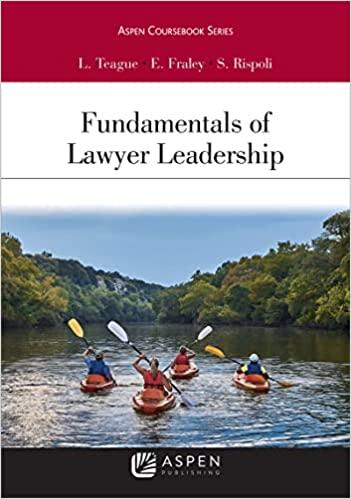Question
Week 4 Assignment Purpose: The purpose of your weekly assignments is to create a quick reference studyguide to assistyou in preparing for the California Real
Week 4 Assignment
Purpose: The purpose of your weekly assignments is to create a quick reference studyguide to assistyou in preparing for the California Real Estate SalespersonLicense Exam
Instructions: Respond to the prompts listed below in all parts (part 1- no need to write complete sentences... write what will help you on the state exam). Copy and paste prompt into a Word doc and save. Submit the assignment by clicking on 'Browse My Computer' then upload. You may also type your responses.
Part 1: Study Guide Chapter 8:
- Identify how contingent clauses work
- Describe the essential elements of a contingency
- Name the common types of contingencies
- Describe the steps involved to prepare a contingent offer
- Distinguish the variouspre-printed forms used to establish a contingency
Chapter 9:
- Distinguish betweenpreapprovalandprequalification
- Describe the underwriting process lenders use to evaluate loan applicants
- Explain the importance of income, net worth, and credit reputation to underwriters
- Discuss the relationship between loan qualifying and purchasing power for buyers
- Summarize TILA and state finance disclosure laws and their requirements
- Name three predatory lending practices and explain how they impact borrowers
Chapter 10:
- Explain the basic elements of a mortgage loan
- Describe the features that distinguish different loan programs
- Discuss the characteristics of conventional and government-sponsored loans
- Explain seller financing options
- Summarize the variety of financing options available to home buyers and why a particular buyer would utilize all of those options... (for ex. FHA because the buyer...)
From now on, I will only grade Part 1. If you'd like additional exercises to help memorize the terms, feel free to continue below. I will post answers for you to review:)
Part 2: Contingent Transactions Identify which of the following forms would be most appropriate for the situations described below.
Listing Agreement Request for Repair Purchase Agreement
Interim Occupancy Agreement Contract for Deed Cancellation of Contract
Contingency for Sale of Buyer's Property Notice to Buyer to Perform
______ 1. The buyer wants the right to have the property inspected, and wants to make the sale contingent on the inspection results.
______ 2. The seller wants to be able to accept backup offers while the buyer is trying to sell his current house.
______ 3. The buyer wants to ask the seller to pay for a new furnace.
______ 4. The deadline for obtaining financing has passed and the seller hasn't heard back from the buyer; she wants to terminate the agreement and sell the property to another buyer.
______ 5. The buyer's deal for selling his current house has fallen through, so he decides to cancel the contract for the new home and just stay where he is.
Part 3: Loan Qualifying Match the appropriate term with the definition listed below.
Income ratio APR Net worth Net equity
Liquid assets Regulation Z Gift letter
Co-mortgagor Preapproval letter Credit score ______ 1. Letter containing maximum loan commitment
______ 2. Relationship between debt and income, or housing expense and income
______ 3. Total finance charges as a percentage of total amount financed
______ 4. When a family member or friend agrees to be liable for a loan
______ 5. Property value minus outstanding liabilities and selling costs
______ 6. Cash and property that can easily be converted to cash
______ 7. Letter to verify that borrower isn't required to repay certain funds
______ 8. Assets minus liabilities Part 4: Financing Programs Match the appropriate term with the definition listed below.
Loan term Note rate Alienation clause
Index Negative amortization Margin
Secondary financing Hybrid ARM Origination fee
Rate caps Refinancing Portfolio loan
Balloon payment Conversion option
______ 1. Additional funds to use for down payment or closing costs
______ 2. Amount of time borrower has to repay loan
______ 3. When unpaid interest is added to a loan's principal balance
______ 4. Allows a borrower to change from ARM to fixed-rate loan
______ 5. Difference between index rate and interest rate charged to borrower
______ 6. Loan that lender doesn't sell to secondary market
______ 7. Initial interest rate charged for an adjustable-rate loan
______ 8. Combination of adjustable- and fixed-rate loan
______ 9. Annual or life-of-loan limits on interest increases
_____ 10. Final amount that may be due at end of loan term
_____ 11. Provision requiring lender's approval for loan assumption
_____ 12. Statistical report lender uses to measure changes in the cost of money
_____ 13. Using new loan to pay off existing obligation
_____ 14. Charge to cover loan processing costs
Step by Step Solution
There are 3 Steps involved in it
Step: 1

Get Instant Access to Expert-Tailored Solutions
See step-by-step solutions with expert insights and AI powered tools for academic success
Step: 2

Step: 3

Ace Your Homework with AI
Get the answers you need in no time with our AI-driven, step-by-step assistance
Get Started


